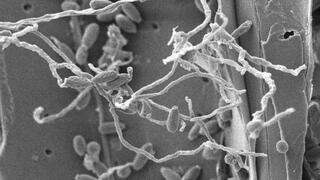Fungus yields a new biomass-digesting enzyme

The oxidase makes plant material easier to break down, increasing sugar yield for biofermentation
The Science
Fungi are responsible for much of the degradation of lignin-rich plant material in natural environments. A team from the University of York and the Great Lakes Bioenergy Research Center isolated a soft-rot fungus that shows exceptional ability to break down lignocellulose. From this fungus, they identified oxidase enzyme activity that effectively cleaves one of the major bonds in lignin, a process that currently requires expensive and time-consuming pretreatment steps. The enzyme also releases potentially useful co-products and makes the remaining lignin more easily digested by other enzymes.
The Impact
Lignin is a major barrier to being able to access more of the fermentable sugars in bioenergy crops. The newly described oxidase activity makes lignocellulosic biomass more easily digested by other enzymes without the need for additional pretreatment steps, potentially improving the efficiency of lignin breakdown while keeping processing costs down. It simultaneously releases compounds with potential pharmaceutical and industrial value, which may improve the economics of biorefining.
Summary
From wheat straw-enriched compost, researchers isolated a soft-rot fungus from the genus Parascedosporium that showed robust enzyme activity and the ability to break down lignocellulose. They identified a new oxidase that effectively cleaved the most common interunit bond in lignin, the β-O-4 ether bond, without the need for any cofactor. The oxidase enzyme also released several useful co-products from wheat straw, including tricin (a flavonoid compound with antioxidant and antibacterial properties), vanillin and p-coumaric acid. Pretreatment of wheat straw with the oxidase enhanced its digestibility by other cellulases, resulting in a 20% increase in the amount of glucose released compared to a control treatment. Integration of this type of enzyme activity into a biorefinery could improve the yield, efficiency, and cost of producing sustainable fuels and chemicals.
Program Manager
N. Kent Peters
kent.peters@science.doe.gov, 301-903-5549
Corresponding Author
John Ralph
jralph@wisc.edu
Funding
This work was funded by the Biotechnology and Biological Sciences Research Council (BBSRC), UK (Grant BB/1018492/1 and BB/P027717/1), the BBSRC Network in Biotechnology and Bioenergy (BBNET), and the Great Lakes Bioenergy Research Center, U.S. Department of Energy, Office of Science, Office of Biological and Environmental Research (DE-SC0018409). The York Centre of Excellence in Mass Spectrometry was created thanks to a major capital investment through Science City York, supported by Yorkshire Forward with funds from the Northern Way Initiative, and subsequent support from the Engineering and Physical Sciences Research Council (EPSRC) (EP/K039660/1; EP/M028127/1).
Publications